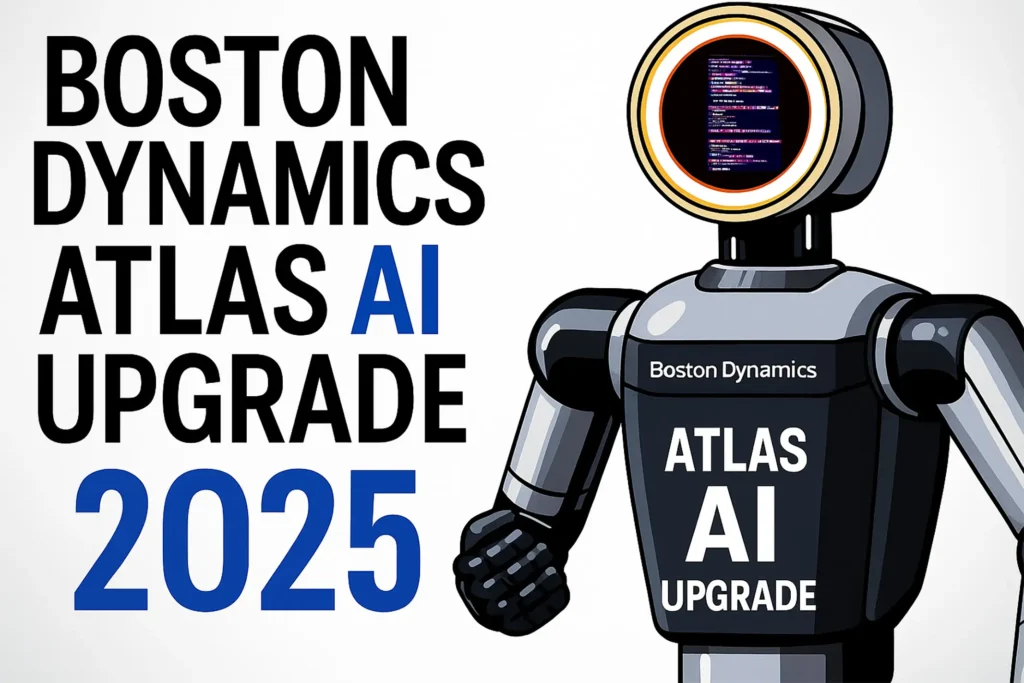2025 is a historic year for robotics, as Boston Dynamics has unveiled the Atlas AI Upgrade 2025, a leap forward in humanoid technology. With advanced artificial intelligence (AI), real-time adaptability, and unmatched physical agility, Atlas is no longer just a research project—it’s stepping into real-world applications. But what makes this upgrade so revolutionary? Let’s dive in.
The Rise of Humanoid Robotics
What Makes Humanoid Robots Different?
Unlike industrial robots, which operate in repetitive, structured environments, humanoid robots are designed to mimic human movements and perform tasks in unpredictable settings. Their ability to walk, jump, and interact naturally makes them ideal for environments designed for humans.
Boston Dynamics’ Role in Robotics Innovation
Boston Dynamics has been at the forefront of robotics for decades. From the early days of BigDog to the versatile Spot, the company consistently pushes the limits of what robots can do. Atlas, their flagship humanoid, has always been a showcase of innovation.
Overview of Atlas Robot
Early Versions of Atlas:
The original Atlas, introduced in 2013, was a hydraulically powered machine designed mainly for research. While it could walk and balance, its movements were rigid and limited.
Key Milestones Before 2025
Over the years, Atlas impressed the world with backflips, parkour, and dancing routines. But despite its agility, it relied heavily on pre-programmed actions rather than genuine decision-making.
Why the 2025 AI Upgrade Matters
The Shift from Pre-Programmed to Intelligent Actions
The biggest leap in 2025 is AI-driven autonomy. Atlas can now learn and adapt on the go, rather than executing rigid commands.
Enhancing Human-Robot Collaboration:
This shift allows Atlas to work alongside humans in dynamic settings—whether it’s assisting in a warehouse, responding to emergencies, or even helping in daily tasks.
Core Features of the Atlas AI Upgrade 2025
Improved Mobility and Balance:
Atlas now moves with smoother, more natural motions, able to navigate uneven terrain and recover from falls without external commands.
Enhanced AI Decision-Making:
Powered by advanced machine learning models, Atlas can assess situations in real time, making smart choices in unfamiliar environments.
Real-Time Learning Capabilities:
With reinforcement learning, Atlas continuously improves by trial and error, much like a human gaining experience.
Integration with Machine Vision:
The upgrade includes high-resolution cameras and LiDAR sensors, enabling Atlas to “see” and understand its surroundings for better object handling and obstacle avoidance.
Atlas in Action: Real-World Applications
Manufacturing and Industrial Use:
Atlas can assist in factories by handling heavy lifting, assembly tasks, and logistics—freeing up human workers for more complex roles.
Search and Rescue Missions:
In disaster zones, Atlas can navigate rubble, identify survivors, and deliver supplies where humans can’t safely reach.
Healthcare and Assistance Roles:
Though still in early stages, Atlas has potential as a mobility assistant for elderly care and rehabilitation support.
Military and Defence Potential:
While controversial, the technology could enhance logistics, reconnaissance, and support missions in defence operations.
AI and Robotics: The Perfect Combination
How Machine Learning Transforms Robotics
Traditional robots follow rules. With AI, Atlas develops an understanding of context, making it adaptable and resilient.
AI-Powered Autonomy in Humanoid Robots
Instead of being “told” every step, Atlas can decide what to do next based on environmental input. This is a game-changer for unpredictable tasks.
Ethical and Safety Considerations
Job Displacement Concerns:
As robots grow smarter, industries fear job losses. But experts suggest they’ll augment rather than replace human workers.
Ethical Boundaries in Robotics:
Should robots be allowed in warfare? Should they replace human caregivers? These debates intensify with every advancement.
Safety Protocols and Human Trust:
Boston Dynamics emphasises fail-safes and ethical use policies, ensuring robots remain tools, not threats.
Boston Dynamics vs. Competitors
How Atlas Stands Out Against Tesla Optimus
While Tesla Optimus focuses on affordability and mass production, Atlas leads in agility and AI-driven intelligence.
Comparison with Sanctuary AI and Figure 01
Sanctuary AI prioritises cognitive functions, while Figure 01 highlights versatility. Atlas blends physical mastery with real-time AI decision-making.
Atlas and the Future of Human-Robot Collaboration
Workplace Integration:
Imagine walking into an office or warehouse where Atlas robots operate seamlessly alongside employees—boosting efficiency and safety.
Household Use Cases:
From carrying groceries to helping with chores, Atlas might one day become the ultimate personal assistant.
The Role of AI in Shaping Atlas 2025
Deep Learning for Movement Prediction:
Atlas uses predictive AI to anticipate and adjust its movements, avoiding slips or missteps.
Natural Language Processing for Communication:
Atlas can understand and respond to voice commands with more nuance than ever before.
Challenges Facing Atlas AI Upgrade 2025
Cost of Development and Deployment:
Cutting-edge robotics isn’t cheap, limiting widespread adoption in the short term.
Public Acceptance:
People remain cautious about humanoids—pop culture often portrays them as threats.
Regulatory Barriers:
Governments must create policies that ensure responsible development and deployment.
Future Possibilities Beyond 2025
Atlas as a Global Workforce Partner:
From construction to healthcare, Atlas could become a universal worker, reshaping industries worldwide.
Role in Space Exploration:
Atlas could assist astronauts on missions, performing tasks in dangerous or low-gravity environments.
Conclusion:-
The Boston Dynamics Atlas AI Upgrade 2025 isn’t just a technological milestone—it’s a bold step toward a future where humans and robots collaborate like never before. With smarter AI, improved agility, and real-world adaptability, Atlas sets the benchmark for the next generation of robotics. While challenges remain, the potential is limitless.
FAQs:-
1. What makes the Atlas AI Upgrade 2025 special?
It introduces real-time decision-making, advanced mobility, and adaptability, making Atlas smarter and more useful in real-world tasks.
2. Can Atlas replace human jobs?
Not entirely. Instead, Atlas is designed to complement human efforts by handling dangerous, repetitive, or physically demanding tasks.
3. How does Atlas compare to Tesla Optimus?
Atlas excels in agility and AI decision-making, while Optimus focuses on affordability and scalability.
4. Will Atlas be available for household use soon?
Not immediately. While the potential exists, current costs and regulations limit household deployment.
5. Is Atlas safe to work with?
Yes. Boston Dynamics prioritises safety, building in fail-safes and ethical guidelines to ensure Atlas operates securely around humans.

